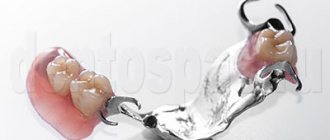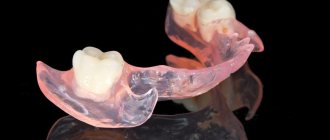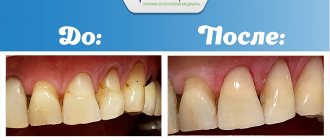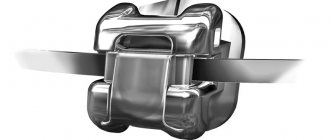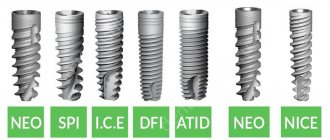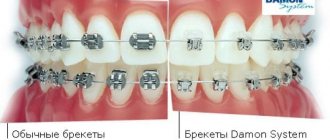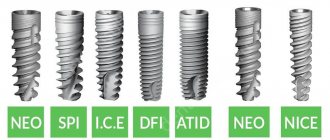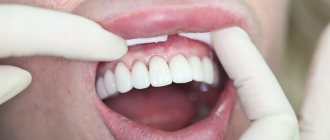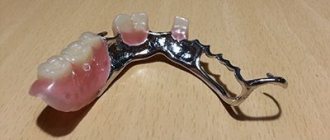Until recently, people who used removable dentures had problems securing the product in the oral cavity. Modern dentistry has many ways to restore chewing functions and the beauty of a smile. The clasp prosthesis received good recommendations from specialists. It is securely fixed on supporting teeth and crowns, allowing a person to feel comfortable and confident.
Depending on the method of creation, prostheses can be precision (made in a factory) or semi-precision (made in a laboratory based on modeling casts). Products have several types of fastening, which have their own advantages and disadvantages.
Clasp design
Such support-retaining mechanisms, which are extensions from the base of the prosthesis, are most often made of metal. This allows you to chew food efficiently and painlessly. The upper clasp fastenings do not affect diction and do not dull the sensitivity of taste buds located on the palate. The design, despite its simple structure, copes with restoring the function of chewing food better than nylon or plastic counterparts.
Design with metal clasps
Due to the destructive effect of metal on enamel, it is recommended to first install abrasion-resistant crowns on the abutment teeth.
The outer part of the clasp is visible on the surface of the teeth, but if the aesthetics of a smile is important to the patient, then the front clasps can be made of invisible polymer materials.
Polymer clasps
Materials
In the manufacture of Quadrotti clasp dentures, the highly flexible Dental-D nylon-based material developed by Italian technicians is used. Its composition, like the entire prosthetic structure, does not include metal elements.
The production uses thermoplastic monomer-free plastic based on polyoxymethylene (polyacetal). The strength of this material is 15 times higher compared to acrylic plastic.
After high temperature treatment, Dental-D acquires the following properties that distinguish it from other dental plastics:
- high strength, providing medium chewing loads;
- low toxicity;
- softness and moderate elasticity;
- the ability to select the color of the material that matches the color of the client’s gums (you can choose clasps and gum tissue red, white or transparent).
- no allergic reactions.
The material for the manufacture of Quadrotti prostheses, like the raw materials for nylon prostheses, belongs to thermal pastes. For casting such plastic, a special thermal injection system was developed, with the help of which dentures are made. Its cost is quite high, which also affects the price of the finished product.
Attachment option (lock fastening)
One of the parts of the micro-lock (attachment) is located on the teeth enclosed in metal-ceramic crowns, and the second is on the clasp prosthesis. The mechanism snaps into place and provides a secure fit.
According to the method of fastening, locks are divided into the following types:
- intra-root, which are held on root caps;
- placed inside the product;
- soldered to the surface of the implant.
Before installing the prosthesis, the specialist cleans the enamel using ultrasound. It is important to cure all pathological phenomena in the oral cavity. A mandatory step is the installation of at least four crowns on the treated and ground abutment teeth. After completing the procedures, the structure is placed on the surface of the jaw.
Lock fastenings have a number of advantages - they are practically invisible, comfortable, and last 5-7 years or more. The design is considered high-tech and requires highly qualified specialists, but is not visible to others.
There are several types of attachments:
- hinged - joint;
- labile - shifting in any plane;
- crossbar - having a small valve;
- anchor - linked by a sphere or a button;
- semi-labile - capable of moving vertically;
- beams - a thin rod between the crowns that fits into the groove on the bottom of the prosthesis.
The choice of prosthesis is made by an orthopedist, focusing on the needs of the patient. The main mechanical impact in a design with a rigid connection is transmitted to the abutment teeth taken under the crowns. In a softer version, the load is evenly distributed over the entire jaw.
According to the level of rigidity, attachments are divided into three types:
- the toughest ones are red;
- medium hard - yellow;
- soft - green.
The locking mechanism quickly weakens, and the locking elements may need to be replaced every year and a half. The cost of repairs is about 100 rubles. The orthopedist removes worn parts and immediately installs new ones.
Varieties
Clasp dentures have different fixations on the remaining teeth. They can be on clasps, on locks and on telescopic crowns. Various prosthetic fixation systems have both advantages and disadvantages, and at the moment we will tell you about both.
Clasp dentures with clasps
This design is fixed using hook-clasps, which very tightly clasp the abutment tooth. Clasps are made of metal. With their help, the denture is firmly held on the jaw and, when chewing, transfers the load to the teeth. In most cases, clasps are cast together with the frame, so this design is highly strong and durable. Clasps are selected individually in accordance with the size and shape of the teeth.
Clasp dentures with locks also have differences in cost: One-sided clasp dentures are used in the case of a one-sided lack of dentition, with contraindications for dental implantation, in the absence of the ability to produce a fixed bridge prosthesis, and in some other cases. Most professionals and professionals in the field of dentistry believe that that at present there is no candidate for clasp dental prosthetics. Now clasp dentures are managed at the appropriate level with their main tasks - the restoration of lost chewing functions and the creation of the cosmetic effect of healthy teeth.
Clasp dentures with locks
Clasp dentures with locks have a strong, lightweight bridge-like structure, which, when chewing, transfers some of the pressure to the supporting teeth. To protect and strengthen the abutment teeth, they are previously covered with metal-ceramic crowns, into which half of the lock is inserted, and the other half is placed on the abutment teeth. When installing the prosthesis, the lock snaps into place.
Locks fixed in the teeth or in the crowns of the teeth provide the highest strength of the prosthesis. In addition, they allow you to firmly fix the structure and simply remove it for repeated cleaning.
They have clasp dentures with locks and several shortcomings. One of them is the complexity of production. Currently, in dental prosthetics, this is the most high-tech design, the production of which requires the highest qualifications of a dental technician and an orthopedic doctor. In the manufacture of such a prosthesis, the highest accuracy of calculation of all parts of the structure is essential.
This leads to the second drawback - the highest price. Their effectiveness in comparison with other types of prosthetics is expressed in the comfort of wearing such a denture and comfortable eating. In addition, they are reliable and have a long service life. The cast iron frame is the main difference between the clasp type of prosthesis and the plastic one. Artificial teeth and a plastic base are fixed to this frame.
Caring for a clasp denture
Also, in each individual case, the cost of a clasp denture will depend on the type of fixation of the prosthesis to the teeth. Clasp prosthetics with locks are an order of magnitude more expensive, because in this case the total price also includes the cost of locks and metal-ceramic crowns.
Clasp dentures have a different price range: It is very comfortable, convenient and comfortable from the mental side. All you need to do is remove the prosthesis often and do ordinary hygiene procedures. Take care of your own clasp denture, then you will never complain about the appearance of stomatitis, changes in speech and discomfort when chewing.
Price of clasp prosthetics
Nowadays, one of the most popular types of dental prosthetics is clasp prosthetics, the price of which depends on different clinical situations. There are ordinary and complex clasp dentures. Complex clasps have a system of clasps; they may have not one, but two iron arcs.
The next difference is the cost. The cost of installing clasp dentures is determined by many reasons. Before creating and installing a partial denture, the dentist prepares the oral cavity: cures the teeth, removes plaque, replaces the supporting teeth with crowns and takes impressions of the teeth. These works should be taken into account; otherwise, the expected cost of prosthetics may actually turn out to be significantly higher.
The clasp denture completely complements the dentition. But artificial teeth, just like natural teeth, require careful care. Caring for a clasp denture is not difficult; you don’t even have to take it off at night.
- conventional clasp prosthesis – from fifteen thousand rubles.
- complex clasp prosthesis – from 20 thousand rubles.
- clasp splinting prosthesis – from 20 thousand rubles.
Thus, clasp dentures with clasps are a good option for dental prosthetics, which has only one drawback - low aesthetics. When you grin, iron hooks may be visible in your mouth. But this applies only to individual cases when installing a prosthesis using another method is simply clinically impossible. It should be noted that the price of this type of prosthesis is higher compared to its plastic counterparts.
- regular clasp prosthesis – from 50 thousand rubles. (with all this, the price already includes the cost of the prosthesis, locks and 4 crowns);
- one-sided clasp prosthesis – from 30 to 5 thousand rubles. (with all this, the price already includes the cost of the prosthesis, 2 crowns and locks).
On telescopic crowns
This method of prosthetics is very common abroad. The supporting teeth are ground down, then metal caps are attached to them using cement. Two crowns are placed on the prosthesis frame. When put on, they are inserted on top of the caps.
The design is invisible during a conversation, evenly distributes the chewing load and is well fixed. This is the most expensive design to install.
Contraindications
The installation of structures is contraindicated in the following cases:
- The presence of less than 4 healthy teeth in the jaw;
- Complete edentia;
- Low level of hygienic care;
- Allergic reaction to the materials used;
- Periodontal disease in stage 3;
- Severe bone atrophy;
- Pregnancy and lactation period;
- Acute viral, bacterial diseases;
- Exacerbation of chronic pathologies of the body;
- Mental disorders;
- Serious diseases that cast doubt on the success of treatment (oncology, tuberculosis, diabetes, AIDS, etc.)
Indications and contraindications for installation
The possibility of installing a clasp is determined during a dental examination. Removable dentures are used in the following cases:
- some molars are missing;
- it is necessary to hide multiple dental defects;
- The patient has been diagnosed with diabetes mellitus and periodontal disease;
- prominent maxillary cusps;
- flat sky;
- pathological weakness of gum capillaries;
- broken bite;
- atrophy of the alveolar processes;
- there is no possibility to install a fixed prosthesis, for example, due to severe inclination of the teeth;
- bruxism (teeth grinding);
- enamel wear is observed;
- it is necessary to restore the aesthetics of the anterior dentition.
The peculiarities of the clasps do not allow them to be installed on damaged abutment teeth affected by caries. There are other contraindications:
- small lingual-buccal space;
- inflammatory process in the area of the roots of supporting teeth;
- periodontitis;
- Lowered crowns were previously installed.
How long does it take to get used to dentures?
Dentists distinguish 3 phases of adaptation:
- The first phase is irritation
. And although doctors mean irritation of nerve receptors, the name of the phase perfectly conveys the patient’s condition. Irritation and the desire to pull out a foreign object are the 2 main feelings of the first day. A psychological attitude and any, preferably enjoyable, activity helps to overcome them. - The second phase is partial braking
.
Then comes the reward for patience and perseverance. Restoration still interferes, but not as much. Salivation decreases, nausea goes away. Cheeks and lips are less tense. Chewing function is restored. This phase takes about 5 days
. - The third phase is complete braking
. Diction is normalized, chewing no longer causes discomfort, and there is no sensation of a foreign body. The patient experiences discomfort when the jaw is not in place. Adaptation is complete.
On average, getting used to dentures takes 10-30 days.
.
Subtleties of care
In order to extend the service life of a clasp prosthesis with locks, it is necessary to comply with the conditions of its operation. It is enough to follow simple rules:
- After each meal, rinse the structure with clean boiled water.
- Clean the denture twice a day using a toothbrush and paste, as well as a special antiseptic solution.
- Visit your dentist regularly for professional cleanings and preventive examinations.
- Avoid too hot food and drinks, chemical and mechanical effects on the prosthesis.
- If necessary, make timely repairs and corrections.
What to do, if
- Nausea because of dentures
. During attacks of nausea, it is recommended to make frequent swallowing movements. Peppermint candies help a lot. They are absorbed, but under no circumstances are they chewed. - There is a strong gag reflex
. Recommendations include the same lozenges and deep, calm breathing. Relaxation occurs faster if the exhalation is longer than the inhalation. For example, inhale for a count of 4, and exhale for a count of 6. You can put salt water in your mouth. You don't need to swallow it, just hold it for a while and spit it out. If nothing helps, you need to see a doctor. He will either make a correction or prescribe special medications. - A lot of saliva is produced
.
This is a temporary phenomenon and will go away in 1-2 days
. And here sweets that you can suck for a long time come to the rescue. The brain will associate salivation with candy rather than with a fake jaw. - The prosthesis rubs
. You need to go to the dentist and have an orthopedist make a correction. You cannot file the structure yourself, as this can lead to damage to the restoration. Before visiting the dentist, the denture must be left in place for at least 3 hours so that the doctor can see the places where the restoration is rubbing.
Leading manufacturers and cost
One of the best laboratories specializing in the manufacture of clasps is AlvaDent. The company is located on the territory of the Russian Federation; Swiss equipment is used for production, guaranteeing product quality.
Ball-shaped fasteners used for fixing clasp dentures on attachments are produced by the Italian concern Rhein-83 and the German company Bredent.
The company CENDRES & METAUX SA DENTAL, located in Switzerland, produces hinged and locking fasteners. An improved locking system was developed here, including 6 types of lock mechanism matrix and one patrix. From this organization you can order semi-labile, labile, beam and rigid spherical attachments.
The price of clasp dentures starts from 45 thousand rubles and depends on the type of product being installed, the clinic and the condition of the patient’s teeth.
Manufacturing stages
Prosthetics consists of the following stages:
- Examination and examination of the patient;
- Making a diagnosis, selecting an orthopedic design;
- Preparation of the oral cavity – professional cleaning, sanitation;
- Taking dental impressions;
- Manufacturing of structures in a dental laboratory;
- Trying on a clasp, choosing a fixation method, teeth color;
- Fixation of the finished product;
- Advice and recommendations for the patient.
Alternative options
Most orthopedists consider clasp dentures to be the optimal way to restore dentition. But at the request of the patient or existing indications, an alternative may be offered.
Nylon constructions or Acry-Free dentures:
Conditionally removable dentures fixed on several implants:
Clasp prosthetics on implants
There are cases when prosthetics are the only possible option for restoring the aesthetics of the dentition, but there are no longer any healthy teeth to attach the prosthesis in the right places. This problem can be solved by using implants. These are artificial teeth that are screwed into the jawbone. Most often these are lateral tooth sockets. After such implants take root and the doctor allows you to move on to prosthetics, the removable structure can be installed according to the standard scheme.
User reviews
Most patient reviews about clasp dentures are positive. But the quality of product installation always depends on the qualifications of the specialist.
I lost several teeth, and the clinic offered to install a denture with attachments. I was pleased with the result. Artificial teeth not only look great, but also do not cause discomfort.
Svetlana, 43 years old
I’ve been using a clasp prosthesis for three years and don’t take it off at night. The design is lightweight, with durable fastening. I was worried about the condition of the enamel, but there were no problems.
Mikhail, 52 years old
During the treatment of periodontal disease, I lost many teeth.
To return a beautiful smile, I decided to install a prosthesis. It was a little confusing that it was necessary to put crowns on healthy teeth, but the result is worth it. Elvira, 38 years old
What are the differences between a clasp prosthesis and a plastic one?
The presence of an iron frame can significantly reduce the volume and thickness of the plastic base on which artificial teeth are attached.
Look at fig. 1-2. The differences between a conventional prosthesis made of acrylic plastic and a clasp version are obvious. When prosthetizing anterior teeth, these differences are significant, since the clasp prosthesis has only a narrow iron arch, and the plastic one has a bulky bridge.
Fig. 1 Plastic prosthesis
The clasp is a narrow iron arch that gives the prosthesis strength and reliability. It can be used in cases where the production of bridge-like permanent structures is not possible. Therefore, a clasp denture can be confidently called an ideal candidate for a flexible nylon or removable plate denture.
Perceptions of patients and independent professionals about clasp dentures
Clasp prosthetics receives positive reviews, mainly for three reasons that are important for patients.
- Long service life. Manufacturers advise using a clasp prosthesis for up to 5 years. This is a fairly long period for removable prosthetics in general, especially if associated with plastic dentures, the service life of which is only 2.5 years.
This significant difference in service life is due to the fact that under clasp dentures, gum tissue and bone tissue atrophy even more slowly than under plastic dentures. The loss of tissue (atrophy) over time leads to the fact that their shape no longer corresponds to the shape of the prosthesis, which means that fixation worsens, pain occurs when wearing, and the like.
- Comfortable to wear. Comfortable installation of clasp dentures is achieved in almost all cases due to the reduction of the plastic base. As a result:
- instead of a bulky plastic base, there is only a narrow iron arch on the upper jaw, which does not cover the frontal part of the palate with the prosthetic base, on which the patient’s taste senses and his diction depend;
- the same narrow arch on the lower jaw gives freedom to the tongue, reducing diction problems and negating the risk of the entire denture falling out due to movements made by the tongue.
- Strength and reliability. The basis of the clasp prosthesis is a cast iron frame, therefore the possibility of breakage of the prosthesis is very small. In Fig. 3 you can see the frame and the plastic base and teeth fixed specifically to it. In the article about nylon dentures, you can see another option for dentures.
Kinds
There are no specific orthopedic devices, the technology of use and names of which have been registered. QuattroTi prosthetic products are manufactured using a single method and using identical models prepared individually. But Quadrotti devices can still be classified in the following areas:
the number of missing teeth - there are both small dentures designed for 1-2 teeth, similar to butterfly dentures, and those designed for installation with multiple included defects, the size of which can reach an entire dental arch;
by the color of the material used to make the hooks - this indicator depends on the shape of the crowns and the location of the hooks themselves (naturally, the artificial teeth themselves are made in white, and the gums are made in pink);
by localization - since QuattroTi prosthetics is used for both the lower and upper jaws, these designs differ (in the absence of chewing teeth in the upper part, an additional bridge is created that connects the product in the lateral parts).
Advantages and disadvantages
Clasp dentures with a clasp type of fixation have the following advantages:
- They are comfortable to use.
- The development of pathological processes in the oral cavity is minimized, since the load during chewing is distributed evenly.
- Diction does not change.
- There is no violation of taste and temperature sensitivity.
- Patients quickly get used to the prosthesis.
- The design is securely fixed in the oral cavity.
Among the disadvantages are:
Photo: Lack of aesthetics when attaching a prosthesis with clasps
- Lack of aesthetics if the hook falls into the smile line.
- It is possible that the clasps may rub the oral mucosa while eating.
- High cost of construction.
